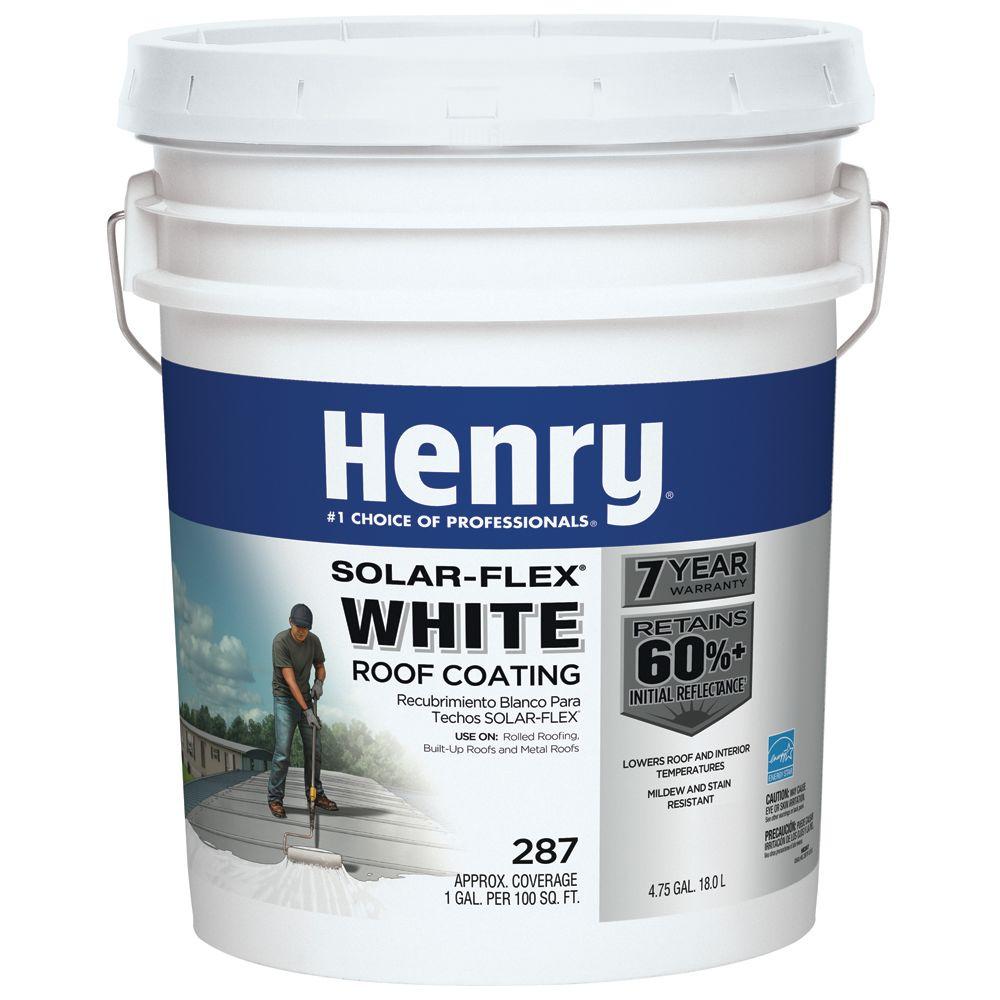Of all the material types for a roof, a liquid roof coating is perhaps the oddest. It has multiple values, several material options and is definitely worth a more in-depth look.
Understanding Liquid Roof Options
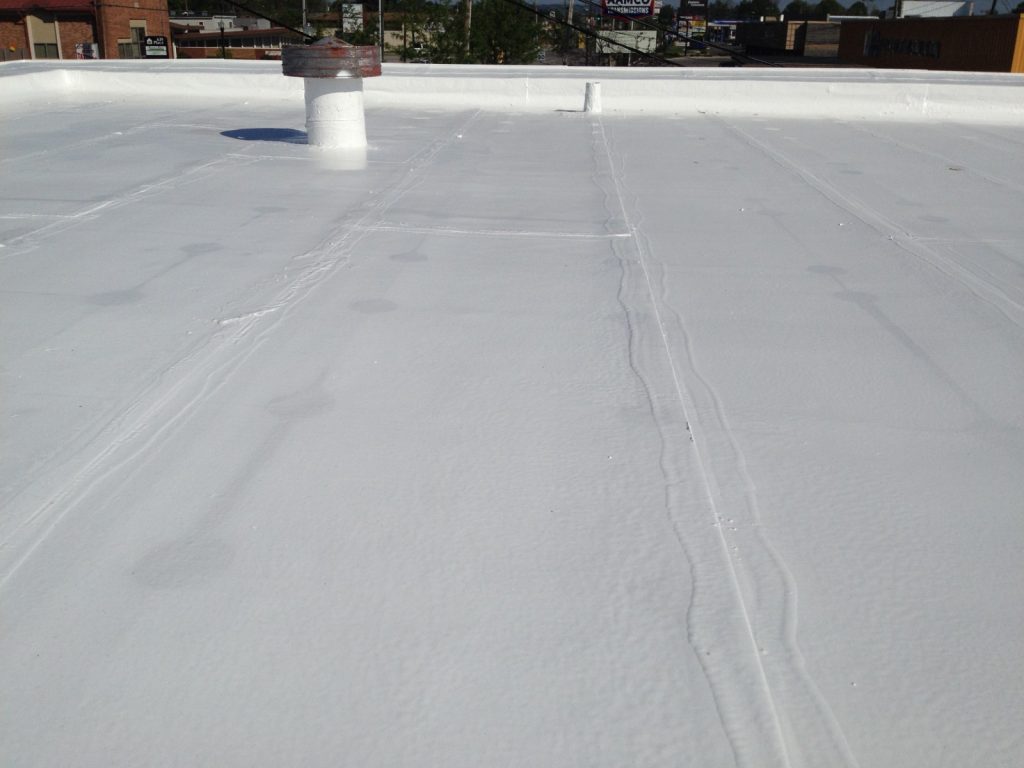
Before the mid-20th century, liquid roof existed, but in an entirely different way than today. It used to be bitumen (think mortar) mixed with fillers, such as sand, straw, and later felt paper.
The one caveat was that bitumen needed to be applied hot. Piping hot, so as to form a liquid that could spread evenly. — And dangerously hot, because at times fires would occur. That’s not good, but it was the norm, until around 1960.
Enter the age of synthetics that amount to plastic and rubber in liquid form being adhered to the roof:
From 1960 to present, there are a wide range of materials such as acrylics, EPDM, asphalt and polyester urethanes. The technical names and variations are numerous while liquid EPDM is arguably the most popular (and least costly option for DIY), though competition like high-end elastomeric silicone, acrylic, and urethane coatings certainly exists.
A key difference is all these new age materials are applied cold, meaning there is zero need to heat them, in order to spread the material on the roof deck. They act as a membrane which encapsulates the roof with a waterproof layer and protects what’s underneath.
Liquid roofing is very popular with the DIY roof protection applications for RVs or motorhomes, along with commercial roofing for added protection on flat roofs. Yet, they work just as well for residential properties that have a flat or low sloping roof. If you are utterly unfamiliar with liquid roof coating, take a look at the application process below:
Cost and Value
A liquid roof coating is otherwise known as sealing or spraying on a roof over the existing low-slope roofing system.
For residential properties, it is likely the roof deck already has some former material on the home that has some known problem, i.e., is leaking or water is pooling up.
So, the cost question is what’s the price to seal the roof? And the answer is, it will vary. — It will depend on what the material is that’s being sealed (or whether it ought to be removed, or just thoroughly cleaned with a pressure washer), what the new material will be, the actual slope of the roof, and the experience along with guarantees the applicator is able to provide.
A fair ballpark for a low-end application can be as low as $2,500 for a liquid roof coating application over the entire roof deck. Possibly as low as $1,500 to $2,000, plus the cost of building permits and tools/ job supplies, and lower if going the DIY route, which for the inexperienced has its obvious drawbacks.
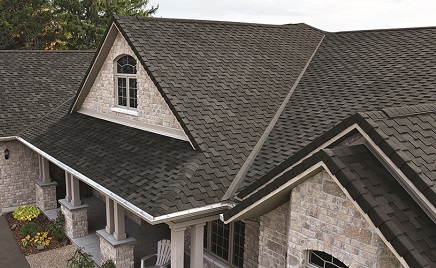 Asphalt Shingles
Asphalt Shingles
$8,500 Average Cost |
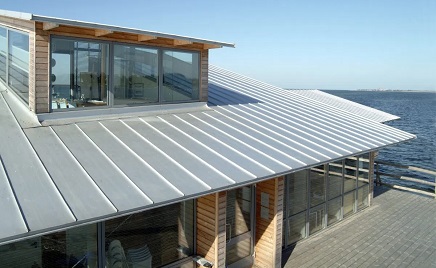 Metal Roof
Metal Roof
$15,500 Average Cost |
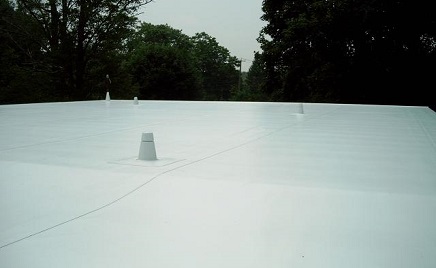 Flat Roof Membrane
Flat Roof Membrane
$11,500 Average Cost |
|
|
||
Handyman Application:
More than $2,500-$3,500 would be extraordinary, but possible if there is more to the job than just adhering the liquid elastomeric coating on a flat roof with little to nothing penetrating from the roof. — Please note that the above prices reflect the cost of hiring a handyman to do the job.
Profession Installation:
If you decide to hire a professional roofing company that will pull the building permit for the job, do everything by the book and stand behind its work, then your cost will likely be a few thousand dollars to have a liquid roof coating professionally applied to a typical residential flat or low-slope roof.
Mid-Range and High-End Spray-on Liquid Roof Coating Applications
Prices for a professional application of a liquid roof coating will likely be as follows:
- Polyurethane coating will cost between $3.00 and $6.00 per square foot to install. Sometimes referred to as polyurethane roof paint, polyurethane coatings have a base coat and a top coat (two different products) and are typically used on commercial flat roofs.– Elastomeric polyurethane coating is relatively easy to install as it adheres well to most surfaces including metal roofs, metal flashing, EPDM rubber, and other surface materials.
- The cost of a standard acrylic coating will typically fall between $3.50 to $6.50 per square foot installed, depending on the level of prep work needed before the liquid roof coating is applied.– Acrylic coatings can be used on a wide variety of surfaces including metal, EPDM, TPO, PVC, modified bitumen, BUR, etc. This elastometic roof coating material is easy to work with and can be used on sloped metal roofs.
— It’s not necessarily recommended for use on roofs where standing/pooling water is an ongoing problem (a silicone roof coating would work better for flat roofs with drainage issues), especially in cold climates with frequent freeze and thaw cycles.
- Silicone is the agreed upon premier roof coating that can be used as a stand-alone roof and as a topcoat layer in SPF roofs, but the high cost of materials and supplies as well as extensive prep work and tedious installation can drive up the installation prices up to $8.00-$10.00 per square foot installed.– However, it is possible to get a quality silicone roof coating installation for $4.50 to $7.50 per square foot installed, depending on the brand and type of silicone coating used, number of layers/applications, and your home’s location.
— Silicone coatings are more difficult to install than acrylic coatings, which is why they cost more but they are an excellent solution for flat roof surfaces with standing or pooling water and cold climates with freeze and thaw cycles where the next level of durability is required.
— Silicone coatings can be extremely slippery and have a tendency to accumulate dirt over time.
- The cost of applying a complete spray polyurethane foam roofing system is significantly greater than a standard liquid roof coating (without the layer of SPF acting as a base), because a complete SPF roofing system requires the initial application of liquid spray polyurethane foam that expands and fully adheres to the roof deck.– The SPF base layer application, is then followed by a reflective elastomeric (elastic to allow for thermal movement) topcoat layer (typically silicone), and granules. However, on a large enough flat roof, the cost of $6.50 to $12.50 per square foot installed is what you can expect.
Metal
Flat
$15,500
$11,500
ROI Details:
With value, we are looking to communicate return on investment (ROI). In our advantages section below, we present the positive values that come from such a roofing application. ROI will depend on material chosen and the overall quality of application.
In general, 10 years of quality sealing ought to be expected. Less than that would be poor application and amount to bad ROI.
Solar-Reflective Liquid Roof Coatings
Cost of Materials for DIY Enthusiasts
With an energy-efficient, liquid-roof coating, the entire roof can be coated with a reflective material, which can make your roof more energy efficient and longer-lasting.
There are many liquid roof products on the market averaging roughly $150-$250 for a 4.75 gallon container. A typical container can be used to cover approximately 250 square feet of roofing surface.
If you would like to have your entire roof coated, you can buy a pallet containing sixteen 4.75 gallon containers of liquid roof product such as Henry Solar-Flex White Roof Coating for about a thousand dollars at Home Depot.
A typical job of professionally applying a liquid roof coating on a low slope roof will likely cost several thousand dollars for a typical residential project.
Is the cost of applying a reflective roof coating a good investment?
Yes, applying a reflective roof coating is an excellent investment.* If the installation costs for a reflective roof coating (which vary) are slightly higher in certain situations, the long-term benefits can easily offer an attractive return on the installation investment, by providing:
- Longer roof life, better durability—coatings protect the roof substrate from destructive UV
- Reduced maintenance costs over the life of the roof; and coatings can provide the bonus of being a water-resistant barrier
- Better budget management due to predictable life extension of the roof (the opportunity to re-coat the roof rather than replace it)
- Reduced installation risks
- Minimal disruption to the occupants, operations during application, construction process, saving money in areas other than the roofing materials and application itself
- A more desirable and comfortable work environment inside the building
- Opportunity for energy credits, tax savings, rebates
*Coatings are considered “restoration” and not a new roof system installation. Therefore, they may usually be expensed in the fiscal year during which they are applied instead of amortizing the cost over the life of the roof (as in a new membrane installation). — This can be a significant tax benefit to some building owners. Check with your CPA or CFO to properly apply this information to your own roof situation.
Is a special contractor required to install a reflective roof coating?
An experienced roofing contractor should apply the reflective roof coating.
Although the coating may look like ordinary architectural coating, successful application and long-term performance requires proper preparation, repair of leaks or damaged areas, and ultimately proper selection of the correct primer and coating system.
Pros and Cons:
What we like
Or more like part 2 of understanding the material, as there is much we didn’t touch on that we now will.
Synthetic roof membranes are usually applied in one of two ways. They are either mechanically attached via screws or nails or they are adhered via gluing. Liquid roof coating is the second method, but bypasses the need for applying the roofing material with additional glue.
So, a major advantage of liquid roof coating is that it truly provides a monolithic roof coating. This means no seams. Seams mean water, and other weather elements, have a place to enter the upper most layer of a home and seep in. Liquid roof coating prevents that.
With flat roofs, which aren’t technically flat, but close enough, an ongoing issue is the accumulation and pooling of water (aka standing water) on the roof deck.
A quality installation on a flat roof will minimize any chances for pooling water. Yet, there are going to be elements, including humans walking on the roof, that impact the roof surface, possibly leaving indentations of some sort.
A liquid roof coating, in today’s market, uses materials that actively resist water pooling. Thus, being designed to withstand standing or pooling water including freeze and thaw cycles is another important advantage of liquid roof coatings (especially silicone coating).
Even if indentations happen over time, which they surely will, the lack of seams leaves it as rather impossible for the water/elements to seep below the surface.
The more well-known advantage is that liquid coatings provide the cool roof value. Typically a white roof will reflect UV rays. And while any color can be used for liquid roofing, white, gray and black are the popular options.
Asphalt liquid roofs can achieve an aluminum color, which is perhaps the most reflective. This means hot air stays outside, and cooler temps staying inside, which for energy efficiency in warmer climates is desired.
Another unique advantage is the slow cure time, or the time it takes for the liquid material to fully adhere and harden on the roof deck. At first glance, this may seem like a disadvantage, until you realize that even when wet, the material provides a waterproof barrier.
The real advantage here, though, is how this slow curing process compares to other materials. Typically, when a roofing job is done, and especially with fully-adhered (glued) membrane type roofs, there is air trapped between the material and what’s underneath (the substrate).
With a slow cure, the crevices are being slowly filled with the material, thus more evenly applied when curing is finished.
With a fast cure, which is the norm for other materials, the crevices of air provide uneven finishes that are more prone to indentation, particularly from hard rains or hail.
The rest of the advantages can be summed up rather shortly, such as:
- only needs one coat application (no priming needed)
- temperature variation is extreme (handles negative temps as well as high heat)
- resistant to ozone, acids, lightning, and animals
- very little to no maintenance
Disadvantages
These are rather few, but there are some disadvantages of liquid roofs. Mostly due to lack of proper installation, which at times even a pro is subject to.
It is vital for proper curing that the material the liquid roof is being applied is clean and dry. If it is not, the coating will still work, but will adhere differently in certain areas.
The material is also rather new, but manufacturer warranties of 10 and 20 years for a topcoat application is what you can expect, depending on the thickness of the topcoat.
However, a proper application including a thorough surface clean-up and prep work and annual roof inspections (and maintenance if there are any cracks to be filled or damage from hail, etc.) may be required for the manufacturer warranty to remain valid.
If a small company/installer is offering you a “no questions asked” installation warranty longer than 10 years without the annual roof inspections/maintenance plan, then it’s probably too good to be true. If the installation warranty comes from an established company, then there is less of a reason to be skeptical.
Pro Tip: If a new company is boasting a long installation warranty, then take it with a grain of salt, or pay the possibly higher rate from the more established company.
Depending on the material, over time it may get brittle and break. Periodic re-coating is generally a reasonable solution here, but this does require regular inspections. While there is no routine maintenance that is needed per se, there are good reasons for routine inspections.
Liquid roof topcoats are usually applied in depths measured by millimeters. For liquid coatings, 15 to 25 millimeters is typical, though can be more if the material calls for it, or the professional roofer feels it’s necessary to fulfill the warranty.
Even though the material has significant advantage of being without seams, it does have disadvantage of not being a great insulator, like other roofing materials. But this is for a coating, and not meant to be the primary material of a roofing system.
The one exception would be a complete spray polyurethane foam roof installed instead of the standard liquid roof coating, as there will be a base layer of insulation from SPF to which the liquid roof coating will then be applied as a protective topcoat.
Need a Pro? Check out Prices from Local Roofers:
Enter your zip code:
 See what local pros charge
See what local pros charge
